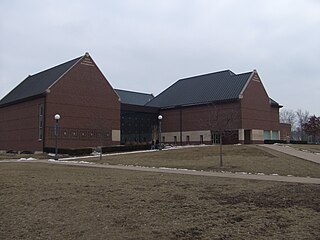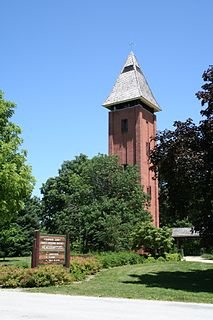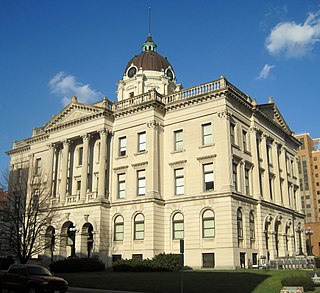
Scouting in Illinois has served youth since 1909. The state was the home of the Boy Scouts of America (BSA) founder, William D. Boyce.

Champaign is a city in Champaign County, Illinois, United States. The United States Census Bureau estimates the city was home to 88,909 people as of July 1, 2019. Champaign is the tenth-most populous city in Illinois, and the state's fourth-most populous city outside the Chicago metropolitan area. It is included in the Champaign–Urbana metropolitan area.

Urbana is a city in and the county seat of Champaign County, Illinois, United States. The population is estimated at 42,214 as of July 1, 2019. Urbana is the tenth-most populous city in Illinois outside of the Chicago metropolitan area. It is included in the Champaign–Urbana metropolitan area.

Bloomington is a city in and the county seat of McLean County, Illinois, United States. It is adjacent to Normal, and is the more populous of the two principal municipalities of the Bloomington-Normal metropolitan area. Bloomington is 135 miles (217 km) southwest of Chicago, and 162 miles (261 km) northeast of St. Louis.

Peoria is the county seat of Peoria County, Illinois, and the largest city on the Illinois River. As of the 2010 census, the city had a population of 115,007. It is the principal city of the Peoria Metropolitan Area in Central Illinois, consisting of the counties of Marshall, Peoria, Stark, Tazewell, and Woodford, which had a population of 373,590 in 2011.

The Champaign–Urbana metropolitan area, also known as Champaign–Urbana and Urbana–Champaign as well as Chambana (colloquially), is a metropolitan area in east-central Illinois. It is the 191st largest metropolitan area in the U.S. It is composed of three counties, Champaign, Ford, and Piatt. The Office of Management and Budget has designated the three-county Champaign–Urbana area as one of its metropolitan statistical areas, which are used for statistical purposes by the Census Bureau and other agencies.

Lincoln's New Salem State Historic Site is a reconstruction of the former village of New Salem in Menard County, Illinois, where Abraham Lincoln lived from 1831 to 1837. While in his twenties, the future U.S. President made his living in this village as a boatman, soldier in the Black Hawk War, general store owner, postmaster, surveyor, and rail splitter, and was first elected to the Illinois General Assembly.

The Abraham Lincoln Presidential Library and Museum documents the life of the 16th U.S. President, Abraham Lincoln, and the course of the American Civil War. Combining traditional scholarship with 21st-century showmanship techniques, the museum ranks as one of the most visited presidential libraries. Its library, in addition to housing an extensive collection on Lincoln, also houses the collection of the Illinois State Historical Library, founded by the state in 1889. The library and museum is located in the state capital of Springfield, Illinois, and is overseen as an agency of state government. It is not affiliated with the U.S. National Archives and its system of libraries.

Conner Prairie is a living history museum in unincorporated south-central Hamilton County, Indiana, United States, which preserves the William Conner home. The home is listed on the National Register of Historic Places, and the museum recreates 19th-century life along the White River.

The Great Platte River Road Archway Monument is a monument on Interstate 80 located three miles east of Kearney, Nebraska, United States. Opened in July 2000, it houses a museum exhibiting the role of Nebraska and the Platte River Valley in the development of America. The monument spans more than 300 feet above Interstate 80 and is accessible via two numbered exits.

The William R. and Clarice V. Spurlock Museum, better known as the Spurlock Museum, is an ethnographic museum at the University of Illinois at Urbana-Champaign. The Spurlock Museum's permanent collection includes portions of collections from other museums and units on the Urbana-Champaign campus such as cultural artifacts from the Museum of Natural History and Department of Anthropology as well as historic clothing from the Bevier Collection of the College of Agricultural, Consumer and Environmental Sciences. The Museum also holds objects donated by other institutions and private individuals. With approximately 51,000 objects in its artifact collection, the Spurlock Museum at the University of Illinois at Urbana-Champaign collects, preserves, documents, exhibits, and studies objects of cultural heritage. The Museum’s main galleries, highlighting the ancient Mediterranean, modern Africa, ancient Egypt, Mesopotamia, East Asia, Oceania, Europe, and the Americas, celebrate the diversity of cultures through time and across the globe.

Central Illinois is a region of the U.S. state of Illinois that consists of the entire central third of the state, divided from north to south. It is mostly an area of flat prairie. The western section was originally part of the Military Tract of 1812 and forms the distinctive western bulge of the state. Also known as the Heart of Illinois, it is characterized by small towns and mid-sized cities. Agriculture, particularly corn and soybeans, as well as educational institutions and manufacturing centers, figure prominently. Major cities include Peoria, Springfield, Decatur, Quincy, Champaign–Urbana, Bloomington-Normal, Galesburg, and Danville.

The John Deere House and Shop is located in the unincorporated village of Grand Detour, Illinois, near the Lee County city of Dixon. The site is known as the location where the first steel plow was invented by John Deere in 1837. The site includes Deere's house, a replica of his original blacksmith shop, a gift shop, and an archaeological exhibit showing the excavation site of his original blacksmith shop. The Deere House and Shop is listed on the National Register of Historic Places; it joined that list in 1966, the year the Register was established. Prior to that, it was designated a National Historic Landmark on July 19, 1964.

Nixon Township is one of thirteen townships in DeWitt County, Illinois, USA. As of the 2010 census, its population was 571 and it contained 250 housing units. The last settled township in DeWitt County was Nixon. The first settlement began in 1850 and the first to locate in this township was Cicero Twist in the spring of 1850. He settled in Section 8 and that year broke a small patch of prairie and raised a crop of sod corn. There had been land cultivated within its boundaries, years before but by parties living outside the immediate area not citizens of the township. Milo Twist, one of eight, was the first white child born in the township and the Twist family lived in a crude cabin constructed of rough logs just as they were cut from native timber. George, William and Morris Nixon were also some of the most early settlers of the area. They were brothers and came from Ohio in the year 1850, settling in different parts of the township. William Nixon and Smith Fuller of DeWitt Township rode on horseback to Houston, Texas, in 1856 in order to buy 500 sheep each. They drove the one thousand head of sheep back to eastern DeWitt County and were the first farmers in the community to have cattle and sheep grazing on the prairies where Weldon now stands. A.M Pue broke the first prairie sod and raised the first crop of corn. In 1859, at the time of the township organization, the commissioners gave the township the name of Nixon in their honor. John Manlove and a brother-in-law, Hiram Chandler, were also early citizens. C S Lisenby improved land in the early days of the township but resided in Creek Township. A Rush and Kate Shipman were the first couple married in the township. John McGinnis was the first postmaster of Nixon Township. The post office was located and housed in a room of an old house on the farm where Duane Riddle later lived in the 20th century. Grains of corn, wheat and oats were to become the main cash crops and were delivered to market by wagon westerly to Clinton and northeast to Mt. Pleasant. During the frozen seasons, delivery was made to Decatur by wagon on roads, or sled on the ice of Friends Creek, running in a southerly direction to the Sangamon River, and to the processing plant of A E. Staley Co Grain. Cattle were also hauled and driven overland to Chicago. On one crossroad a store, blacksmith shop and a schoolhouse formed the first settlement of Shoo Fly and was directly northeast of the present village of Weldon. With many bushels of grain and many head of cattle to be marketed, accompanied by a demand for raw materials, a railroad was soon found to be needed. At this time the government entered the picture and gave every sixth mile of land to a division of the Wabash, St Louis & Pacific Railway. This was used to form a railroad called "The Peanut Line," which ran from Champaign to Havana, Illinois, a total of 110 miles. The history of this railroad dates from the incorporation of the Monticello Railroad Co. on February 21, 1861. The line from White Heath to Havana, an extension from Monticello to Decatur, was completed by the Havana, Mason City, Lincoln & Eastern Railroad. The village there was named in honor of Lawrence Weldon, a prominent lawyer of Bloomington, Illinois, who was also an attorney for the railroad, and took an active part in determining where the railroad would be built. In 1872 a town of Weldon was laid out adjacent to the railroad, and stores were built one block north of the present main street. This section was destroyed by fire in the summer of 1879 and new stores were built at the present location. The village of Weldon, Illinois, was surveyed and platted by surveyor John Brown, in the spring of 1872. It was placed on record in the fall of 1873, by Colonel Thomas Snell, Charles S. Lisenby, James Alexander and James DeLand. Charles S. Lisenby, rich landowner, sold his land in parts, invested in and helped develop the village of Weldon. The first two-story home was built by Lisenby in 1872. The first church started in 1872, on land donated by Colonel Snell, for that purpose. The first store was built in 1873. The Winslow Brothers operated this store. The first stock consisted of drugs and groceries, but soon merged into a general store. The building was a framed construction, 20 by 60 feet and two stories high. It was located between Water and North Street. It was destroyed by fire in the summer of 1879. The next stores were built on the next block south, which is known as High or Main Street. Grains of corn, wheat and oats were to become the main cash crops and were delivered to market by wagon westerly to Clinton and northeast to Mt. Pleasant. During the frozen seasons, delivery was made to Decatur by wagon on roads, or sled on the ice of Friends Creek, running in a southerly direction to the Sangamon River, and to the processing plant of A E. Staley Co Grain. Cattle were also hauled and driven overland to Chicago. On one crossroad a store, blacksmith shop and a schoolhouse formed the first settlement of Shoo Fly and was directly northeast of the present village of Weldon. The next several years Weldon was a very progressive little town. It boasted two hotels, two general stores, a grocer, two restaurants, a confectionery, a meat market, a drug store, one millinery shop, operated by Nora Reed (Baker), two barber shops, a lumber and coal yard and three grain elevators. The first blacksmith shop was built in 1873. It was operated by James Paulson. The first hotel was built and operated by John Bennett in 1874. The first postmaster of Weldon was J. C. Coulter, in 1873. The post office was located in the depot. At that time, Weldon's inhabitants numbered about 600. It was one of the most progressive and best conducted villages of its size in the state. C. J. Seaborg was the operator of a wagon and carriage factory, established in 1874. It is said that some of Weldon's first autos were assembled in his shop. There were stockyards in the west part of town, J.H. Scott and Robert Given being two of the early buyers, driving the livestock to town on foot. Mrs. J.T. Thomas owned a loom and in her home she wove many rag carpels, which were sold around Weldon. Mr. George W. Baker sold furniture, farm implements, silverware, jewelry, etc., in his store. Mr. Baker was also the local undertaker. There was also a men's clothing store for many years. A bank was first organized as a private concern by Jacob Swigart in 1887. It was later organized as a state bank in 1906, with Carl Swigart as president, D.M. Smallwood, vice president, H.T. Swigart, cashier, and Charles C. Lisenby, assistant cashier. Weldon was incorporated in 1892. The first meeting of the board of trustees of the village was held in Worship Gray's office, August 15, 1892. T.C. Byland presided, A.M. Drew, C.J. Seaborg, Robert Given and J.H. Scott were the board members, with C.L. Townsend as clerk. On a motion by Dr. Drew, seconded by C.J. Seaborg, a committee was appointed to draft a municipal code for the government of the village of Weldon. Robert Given, T.C. Byland and J.M. Scott were appointed to draft this code. It was voted that the ordinance of Clinton be adopted as much as would pertain to the village of Weldon. The records show that T.C. Byland was paid $15.00 for writing it. Plans were soon made to build many board walks, also a town house, a prison or a calaboose. A calaboose was needed as there were three saloons at this time or soon after. The calaboose was built on a lot belonging to William Gray, purchased by the village for $25.00. Labor to build the building was $23.75. The lumber was hauled from Clinton, with horses. More information may be found at https://dewitt.illinoisgenweb.org/nixon.htm and at http://www.archive.org/stream/honortoourherita00weld/honortoourherita00weld_djvu.txt
Stanley Matthew Mitruk was an American artist who worked in the Modernist style. He worked in the Chicago area during the 1940s, 50's and 60's.

Lake of the Woods Forest Preserve is a county park of 900 acres (360 ha) in size, located adjacent to Lake of the Woods, Illinois, USA. It is operated by the Champaign County Forest Preserve District, a governmental agency of Champaign County, Illinois, and the forest preserve district has built their headquarters in the park.

The McLean County Museum of History is an AAM accredited institution located in Bloomington, Illinois. It is the principal asset of the McLean County Historical Society, an Illinois nonprofit organization, which was founded in 1892 to study local history. The museum moved into its current location in 1991.

The Champaign-Decatur CSA, also known as East Central Illinois CSA, is a combined statistical area in Illinois. It is the 104th largest combined statistical area in the U.S. It is composed of four counties, Champaign, Ford, Piatt and Macon.
The University Library at the University of Illinois at Urbana–Champaign is the network of libraries, including both physical and virtual library spaces, which serves the University's students, faculty, and staff, as well as scholars and researchers worldwide. The University Library continues to evolve to serve the needs of the University of Illinois at Urbana–Champaign campus.

The Old Depot Museum is a history museum located in Ottawa, Kansas. The focus of the museum is primarily on the regional history of Franklin County, and the importance of trains to the development of small towns. It features history of local Native Americans, local industries, and has accurate recreations of historical rooms. The Old Depot Museum is on the National Register of Historic Places.
















